Castles in France: Explore France’s Most Historic & Beautiful Châteaux
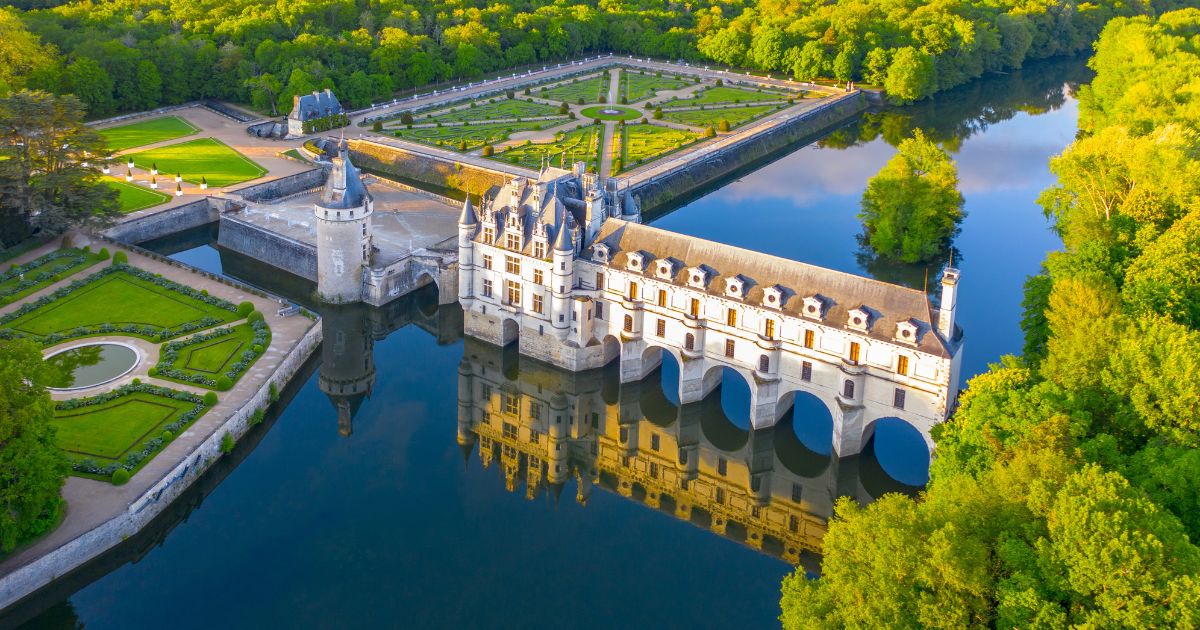
Castles in France are more than architectural showpieces – they’re living chapters of French history. From the soaring medieval strongholds that shaped the Middle Ages to the Renaissance châteaux that redefined elegance and power, France holds one of the richest collections of fortified sites anywhere in Europe. Whether perched along the Loire, guarding ancient trade routes, or serving as lavish royal residences, these castles reveal the evolution of French culture, politics, and artistry over a thousand years.
This guide explores the most iconic castles in France, the eras and styles that shaped them, and practical tips for planning a castle-filled journey through one of Europe’s most enchanting destinations.
Key Takeaways
- France is home to over 45,000 registered châteaux, ranging from medieval keeps to Renaissance palaces.
- The Loire Valley is the epicenter of French castle culture, famous for its lavish Renaissance estates.
- French castles reflect distinct eras: medieval defense, Gothic verticality, Renaissance refinement, and classical symmetry.
- Many castles today feature restored gardens, cultural festivals, art exhibits, and seasonal events.
- Castles play a major role in French heritage tourism, drawing millions of visitors annually.
Historical Overview of Castles in France
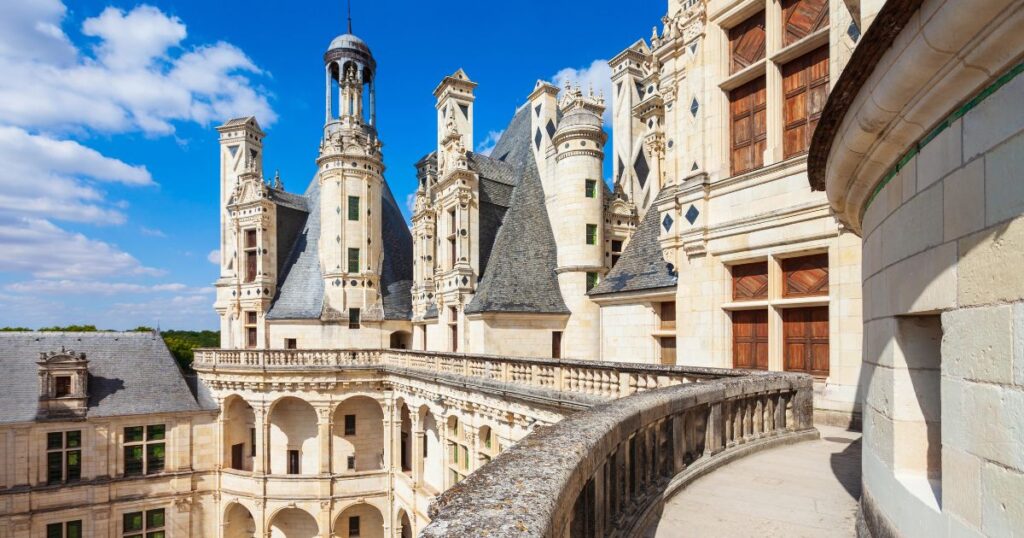
France’s castle tradition spans more than a millennium. The earliest fortifications appeared during the 9th and 10th centuries as wooden motte-and-bailey structures built to defend territories from invasions. By the 12th century, stone fortresses rose across the kingdom, including formidable keeps, curtain walls, and round towers developed to counter siege warfare.
The Hundred Years’ War accelerated castle construction, especially in strategic regions such as Normandy, Aquitaine, and the Loire Valley. As warfare evolved — and royal authority strengthened — castles gradually transformed from defensive outposts into symbols of aristocratic prestige.
By the 16th century, France embraced the Renaissance, importing Italian design principles that turned fortresses into palaces. The Loire Valley became the playground of kings, queens, and nobles who built châteaux as expressions of wealth and culture rather than military might.
Notable Eras & Architectural Evolution
French castles evolved dramatically over the centuries, shaped by warfare, shifting royal power, regional identity, and artistic revolutions. Understanding these eras helps visitors appreciate why French châteaux look so different from one region—or century—to the next.
Medieval Period (10th–14th Centuries): The Age of Fortresses
The earliest French castles were built for survival, not beauty. Rising from motte-and-bailey earthworks into stone strongholds, these medieval fortresses were engineered to repel invaders and assert territorial control. Characteristics of the Medieval era include:
- Towering stone keeps (donjons) as last-resort defensive refuges
- Moats, drawbridges, and fortified gatehouses
- Thick curtain walls reinforced by round towers
- Narrow arrow slits and murder holes for defense
- Strategic hilltop or riverside positioning
These castles reflect the instability of feudal France, where local lords and powerful dukes maintained their own military domains.
Gothic Era (12th–15th Centuries): Stronger Engineering, Soaring Lines
As architectural knowledge expanded, castles began to incorporate Gothic innovations. The style that defined French cathedrals also influenced defensive structures. Key elements of the Gothic era include:
- Taller towers emphasizing verticality
- Wider windows protected by improved defensive design
- Stronger ribbed vaulting and flying buttress-inspired engineering
- Decorative stonework, even on otherwise utilitarian structures
The Gothic era bridges the moment when castles shift from purely military installations to symbols of feudal prestige.
Late Medieval to Early Renaissance (15th Century): Defense Meets Comfort
By the late Middle Ages, the threat of large-scale siege warfare declined, and nobles began adding comfort-focused enhancements. Typical enhancements of the Late Medieval to Early Renaissance period were:
- Enlarged residential wings
- Grand halls and ornate fireplaces
- Improved private chambers
- Expanded courtyards and gardens
Castles still retained fortifications, but the emphasis started moving toward aristocratic living.
Renaissance Era (15th–16th Centuries): Castles Become Palaces
The Renaissance transformed France’s castles into some of the most beautiful residences in Europe. Influenced heavily by Italian art and engineering, French châteaux embraced proportion, harmony, and ornamentation. During this period, some of the defensive features faded and were replaced by these features:
- Symmetrical façades
- Expansive windows
- Sculpted stone galleries
- Ornamental gables and turrets
- Signature French Renaissance staircases (including Chambord’s famed double-helix)
This was the era that produced the Loire Valley’s iconic châteaux – Chenonceau, Chambord, Amboise, Villandry, and more – built to impress visiting dignitaries rather than repel invaders.
Classical & Baroque (17th–18th Centuries): Monumental Royal Power
Under the Bourbon monarchy, castle architecture reached a peak of theatrical grandeur. The shift from “castle” to “palace” was complete. Distinctive elements include:
- Enormous symmetrical wings
- Columned façades and sculpted pediments
- Lavish interiors filled with frescoes, tapestries, and gilded moldings
- Immense formal gardens designed by André Le Nôtre
- Expansive courtyards ideal for hosting the royal court
Versailles is the greatest example, a palace that reshaped European royal culture and set the standard for aristocratic splendor across the continent.
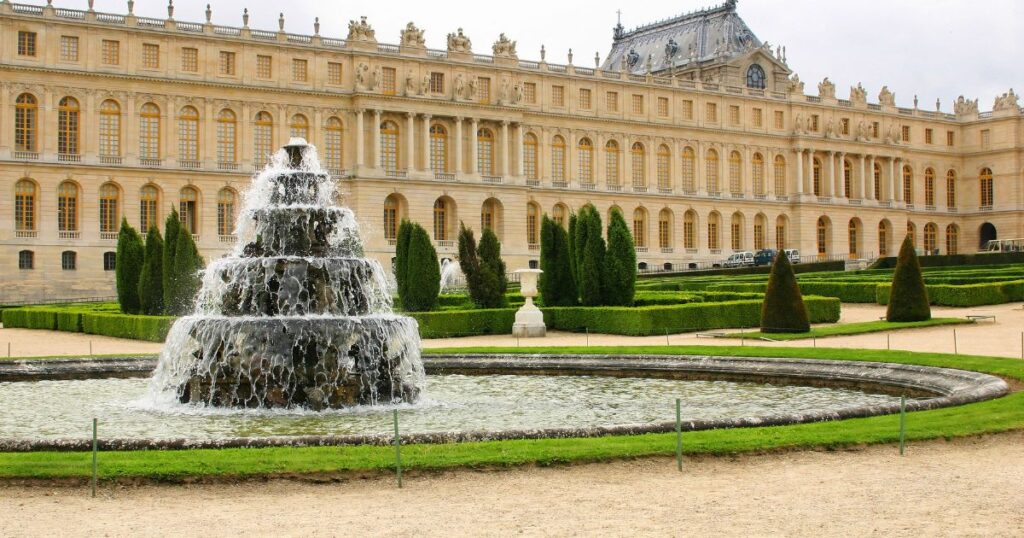
19th-Century Revival & Romanticism: A Return to the Medieval Imagination
During the Romantic era, there was a renewed fascination with France’s medieval past. Architects such as Eugène Viollet-le-Duc led restoration campaigns that reimagined crumbling fortresses with a creatively idealized medieval flair. Significant features of this period include:
- Neo-Gothic towers and battlements
- Reconstructed ramparts
- Romanticized interiors
- Emphasis on picturesque, dramatic silhouettes
Many castles we view as “medieval” today – such as Pierrefonds – are, in part, 19th-century creative reconstructions inspired by a love of legend and chivalry.
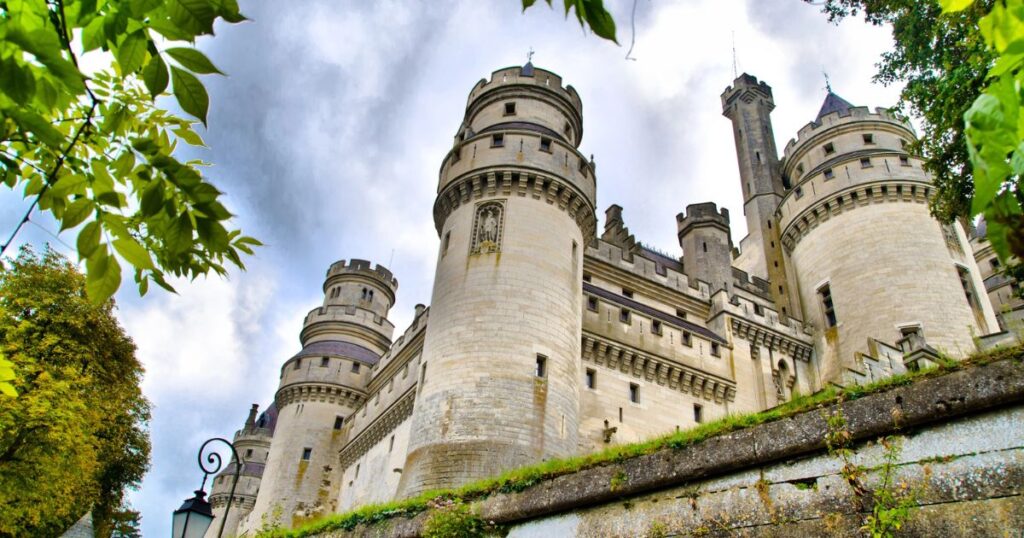
Architectural Styles & Design Elements in French Chateaux
French castles showcase one of Europe’s most diverse architectural landscapes, shaped by shifting military needs, royal ambitions, artistic movements, and regional traditions. Each château or fortress carries layers of history in its stones, from battle-scarred towers to elegant Renaissance façades. Understanding these design elements helps visitors appreciate why a castle in Normandy looks entirely different from one in the Loire Valley – or from a palatial estate outside Paris.
Medieval Military Engineering
Early French castles were built with one goal: defense. Their design focused on strength, height, and deterrence. Typical elements from this time period include:
- Massive stone keeps (donjons): towering central structures serving as last-resort refuges.
- Thick curtain walls: engineered to absorb arrows, stones, and battering.
- Moats and drawbridges: essential for slowing attackers and funneling entry.
- Gatehouses with portcullises: controlled access and protected the primary entry point.
- Arrow loops and murder holes: allowing defenders to strike from protected angles.
These castles prioritized strategic positioning – often on cliffs, promontories, or river bends.
Gothic Influences
As Gothic architecture flourished in cathedrals and civic buildings, many of its engineering advancements shaped castle design as well. Some key Gothic features include:
- Pointed arches that distributed weight more efficiently.
- Higher towers with slender forms and improved visibility for defense.
- Ribbed vaulting used within great halls and chapels.
- Expanded windows—still secure, but larger thanks to stronger walls.
- More decorative stonework, especially on chapels and residential wings.
Gothic castles balanced military might with growing architectural elegance.
Renaissance Refinement
The Renaissance brought a dramatic shift from fortification to aesthetic expression. Inspired by Italian art and humanist ideals, French architects embraced harmony, proportion, and ornamentation. During this period, defensive features were replaced by some of these elements:
- Symmetrical façades with orderly rhythms of windows.
- Classical columns, pilasters, and pediments inspired by ancient Rome.
- Grand staircases (like Chambord’s double-helix) as architectural centerpieces.
- Ornate sculptural reliefs and carved cornices.
- Large mullioned windows that flooded interiors with light.
- Terraced gardens connected seamlessly to the château.
This era produced some of France’s most recognizable castle silhouettes – airy, lavish, and built for courtly life.
French Baroque & Classical Grandeur
During the 17th and 18th centuries, castles evolved into palaces and pleasure estates. Architects pursued theatrical scale and royal symbolism. Design hallmarks of this period include:
- Sweeping symmetrical wings extending from monumental central blocks.
- Columned porticoes and classical orders used on grand exteriors.
- Formal French gardens laid out in geometric precision.
- Decorative roofs with elaborate chimneys and dormers.
- Lavish interior decoration, including gilded moldings, frescoes, and marble halls.
- Expansive courtyards designed for processions and royal audiences.
Versailles defined the era: a palace not just to be lived in, but to behold.
Regional Variation
France’s castles reflect centuries of local identity, and the architectural landscape shifts dramatically as you move from one region to the next. Geography, political history, and cultural influence shaped each region’s approach to design, resulting in a captivating diversity of silhouettes – from rugged Norman keeps to pastel Renaissance palaces. This regional variation allows castle lovers to experience a wide range of styles without ever leaving the country.
- Normandy: Known for its powerful medieval fortresses, Normandy’s castles often feature Romanesque arches, heavy stone construction, and broad defensive walls. Many were shaped by the Hundred Years’ War and the ambitions of Norman dukes.
- Alsace: On France’s eastern border, Alsace blends Germanic and French architectural traditions. Expect steep-roofed towers, half-timbered buildings, and hilltop castles with sweeping views over vineyards and river valleys.
- Occitanie: The south is defined by dramatic Cathar fortresses perched on limestone cliffs. These castles often appear to rise out of the rock itself, emphasizing strategic defense and breathtaking natural scenery.
- Loire Valley: The heartland of Renaissance architecture, where defensive castles transformed into elegant courtly estates. Here you’ll find river-spanning châteaux, sculpted façades, and grand avenues lined with manicured trees.
Every region offers something distinct, making a castle tour through France as varied as it is visually striking.
Decorative & Functional Interior Elements
Stepping inside a French castle reveals another layer of history – one shaped by domestic life, artistic trends, and the evolution of noble comfort. Interior design changed dramatically from the medieval era to the Classical age, transforming stark fortresses into richly adorned residences reflecting the tastes of their owners. Key interior features include:
- Great halls: Once the center of medieval life, these vast rooms hosted feasts, council meetings, and ceremonies. Their soaring timber frames and stone walls speak to an era of communal living and noble authority.
- Stone spiral staircases: Ingeniously engineered, these staircases often tightened clockwise to hamper right-handed attackers ascending during a siege. Later, they became elegant architectural flourishes in Renaissance and Baroque designs.
- Fireplaces and chimneys: Medieval castles relied on monumental hearths carved with noble crests. By the Renaissance, fireplaces became works of art decorated with sculpted stone, painted panels, and intricate mantels.
- Tapestries and wall hangings: Far more than decoration, tapestries provided insulation while telling stories of myth, war, and daily life. Many French castles still display original woven works.
- Private chambers: As warfare waned, interiors shifted toward comfort. Noble families added richly furnished bedrooms, salons, galleries, and libraries—introducing new ideas about privacy, luxury, and domestic refinement.
Together, these elements reveal a progression from practicality to elegance, mirroring broader changes in French society.
Landscaped Gardens & Outdoor Designs
French gardens have long been an extension of the château – outdoor expressions of power, wealth, and artistic vision. From medieval kitchen plots to the geometric perfection of Baroque parterres, these landscapes are masterpieces in their own right. Many visitors discover that the grounds surrounding a castle are just as impressive as the architecture itself. Common landscape features include:
- Symmetrical parterres: Exactly patterned flowerbeds edged with low boxwood, often viewed from an elevated terrace or gallery. These geometric designs symbolized order and control.
- Reflecting pools and water features: Renaissance and Classical gardens frequently incorporated ponds, fountains, and canals that enhanced symmetry and created dramatic visual effects.
- Long, tree-lined avenues: Designed to draw the eye toward the horizon—or back toward the château – these alleys made dramatic settings for royal processions and leisurely strolls.
- Terraced lawns: Especially common in the Loire and southern France, terraces provided layered garden landscapes with sweeping views across river valleys or rolling countryside.
- Topiary and mazes: Popular during the Renaissance, shaped hedges and labyrinths offered both amusement and aesthetic harmony, showcasing the artistry of royal gardeners.
Whether strolling through manicured parterres or exploring shaded forest paths, castle gardens remain an essential part of the French château experience.
Famous Castle Regions in France
France’s castles are distributed across the country in distinct clusters, each shaped by regional history, political influence, and landscape. From fortified Norman battlements to the Renaissance elegance of the Loire, these regions offer completely different castle-travel experiences. Exploring multiple areas reveals how geography and culture influenced both design and purpose – and why no two French châteaux feel the same.
The Loire Valley
Often called the “Garden of France,” the Loire Valley is the country’s most iconic castle region. Here, medieval fortresses evolved into lavish Renaissance estates as French kings and nobles transformed the valley into a stage for courtly life. Signature features of Loire Valley châteaux include:
- Ornate Renaissance façades
- Symmetrical wings and grand staircases
- Expansive riverfront views
- World-renowned gardens
This is where you’ll find Chambord, Chenonceau, Villandry, Amboise, and Cheverny – some of the most photographed and visited châteaux in Europe. The Loire is ideal for travelers seeking beauty, history, and a concentration of easily accessible sites.
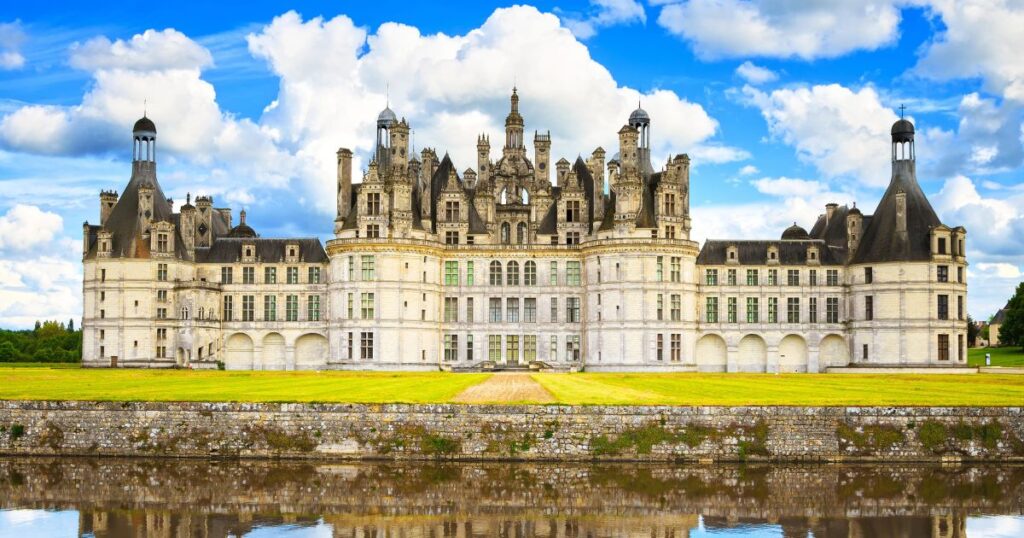
Normandy
Normandy’s castles reflect centuries of military conflict, from Viking incursions to the Hundred Years’ War. Castles here are rugged, defensive, and steeped in the power struggles that defined medieval France and England. You can expect to see some of these details in castles in the Normandy region:
- Romanesque fortifications
- Massive stone walls
- Towering keeps and gatehouses
- Strategic riverside or hilltop locations
Normandy’s most famous sites include Château de Caen, Château de Falaise, and the fortified island abbey–fortress of Mont-Saint-Michel, which, while technically an abbey, plays a similar defensive and symbolic role in French medieval architecture.
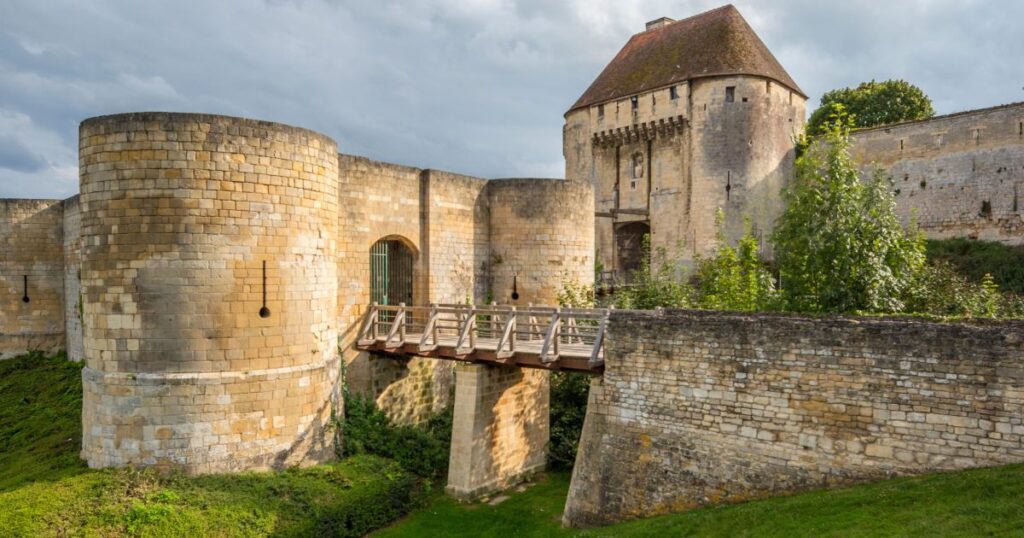
Île-de-France
Surrounding Paris, this region is home to some of France’s most influential royal estates. Here, castle design shifted from military necessity to political theater, culminating in monumental palaces that showcased the power of the French monarchy. These are some of the characteristics of castles in this region:
- Classical and Baroque architecture
- Lavish interiors tied to royal ceremony
- Vast formal gardens and reflecting pools
- Architectural innovations that spread across Europe
Top sites include Versailles, Fontainebleau, and Vincennes, each reflecting different eras of royal ambition.

Occitanie
In southern France, the castles of Occitanie tell dramatic stories of rebellion, religious conflict, and strategic defense. This region contains many of the famed Cathar fortresses, perched high on rocky promontories. These castles are known for these interesting elements:
- Breathtaking cliffside locations
- Narrow mountain approaches
- Stark stone walls merging with natural rock
- Strong ties to medieval legends and the Albigensian Crusade
Highlights include Carcassonne, Montségur, Peyrepertuse, and Quéribus – each offering unforgettable panoramic views and deep historical intrigue.
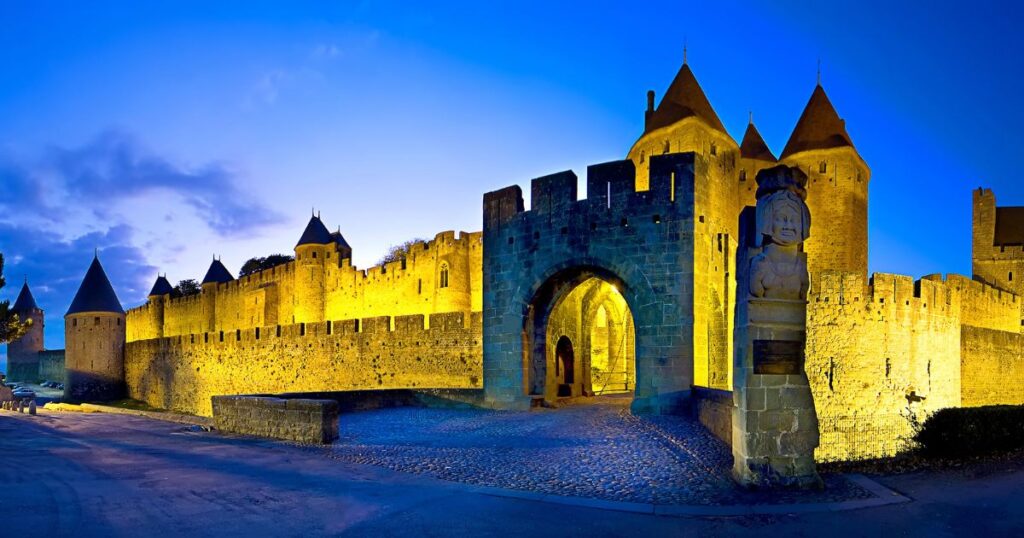
Alsace & Lorraine
Bordering Germany, Alsace and Lorraine blend French and Germanic architectural traditions. Castles here often shift between cultural influences due to a long history of territorial exchanges. Regional features of Alsace & Lorraine typically include:
- Steep-roofed towers
- Timber-framed outbuildings
- Decorative stonework with Central European influences
- Castles perched above vineyard-covered hills
Notable sites include Haut-Kœnigsbourg and Château de Fleckenstein, both offering dramatic views over the Rhine plain.
Brittany
Brittany’s castles reflect Celtic heritage, maritime strength, and centuries of semi-independent regional identity. Fortifications here defended ports, controlled trade routes, and projected ducal power. Architectural traits of Brittany typically include:
- Round defensive towers
- Coastal fortresses guarding harbors
- Granite construction resistant to the Atlantic climate
Key castles include Château de Suscinio and the ducal palace in Nantes, which blends medieval and Renaissance styles.
Provence & the French Riviera
While not as castle-dense as the Loire or Occitanie, Provence offers fortified hill towns and medieval strongholds shaped by Mediterranean influences. Some of the elements you can expect to see in this region are:
- Warm-hued stone walls
- Strategic hilltop designs overlooking olive groves and vineyards
- Lighter, more open defensive structures suited to southern climates
Sites like Château des Baux-de-Provence offer striking ruins with cinematic landscapes.
Top Castles to Visit in France
With more than 45,000 registered châteaux across the country, France offers an overwhelming number of castles to explore. This list highlights some of the most historically important, visually striking, and traveler-friendly sites – castles that offer a clear window into France’s evolution from medieval power to Renaissance brilliance. Each entry retains your preferred short-form descriptor style while still providing meaningful context for trip planning.
Château de Chambord
A Renaissance masterpiece with its famed double-helix staircase, Chambord blends Italian inspiration with French grandeur and features one of the most iconic rooflines in Europe.
Versailles
France’s most famous royal palace and a symbol of absolute monarchy, Versailles dazzles with its Hall of Mirrors, ceremonial apartments, and vast Baroque gardens designed for royal spectacle.
Carcassonne
A walled medieval citadel overlooking the Aude River, Carcassonne offers double ramparts, watchtowers, and atmospheric cobbled streets that immerse visitors in the Middle Ages.
Château de Chenonceau
Known as “The Ladies’ Castle,” this elegant château spans the River Cher and reflects centuries of influence from the powerful women who designed, expanded, and safeguarded it.
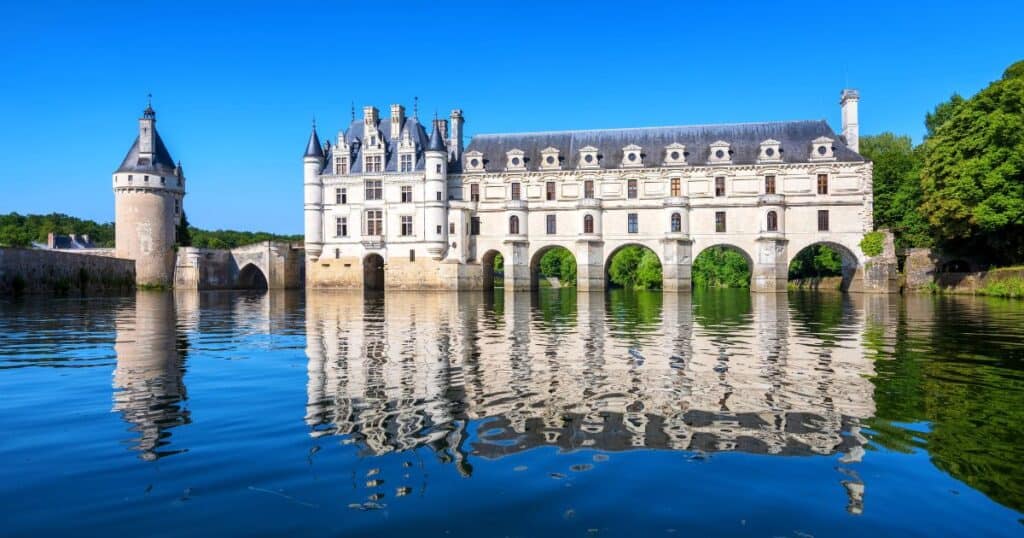
Château de Fontainebleau
A royal residence for more than 800 years, Fontainebleau combines medieval foundations with Renaissance wings and richly decorated interiors favored by kings and emperors alike.
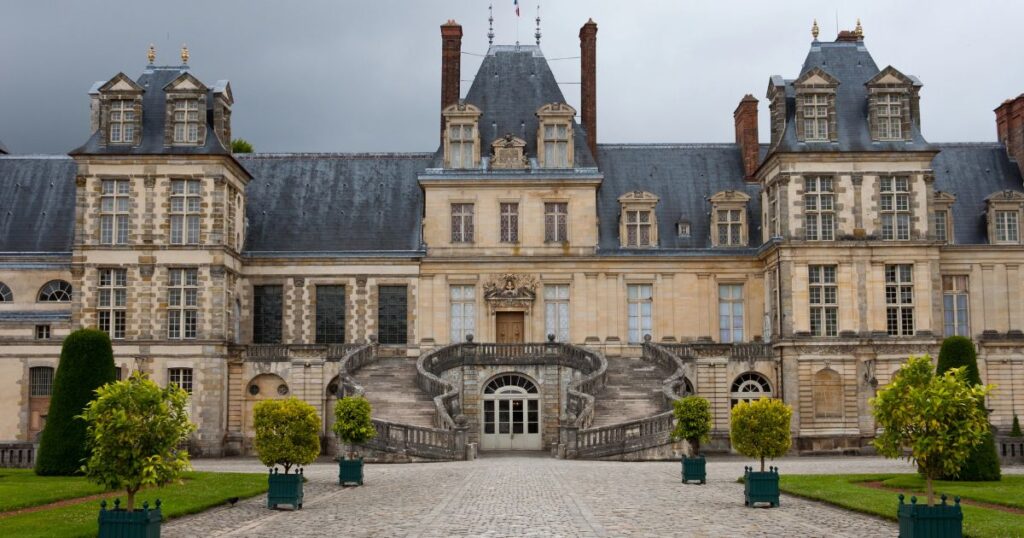
Château d’Amboise
A royal stronghold and the final resting place of Leonardo da Vinci, Amboise pairs medieval fortifications with early Renaissance design and stunning views over the Loire.
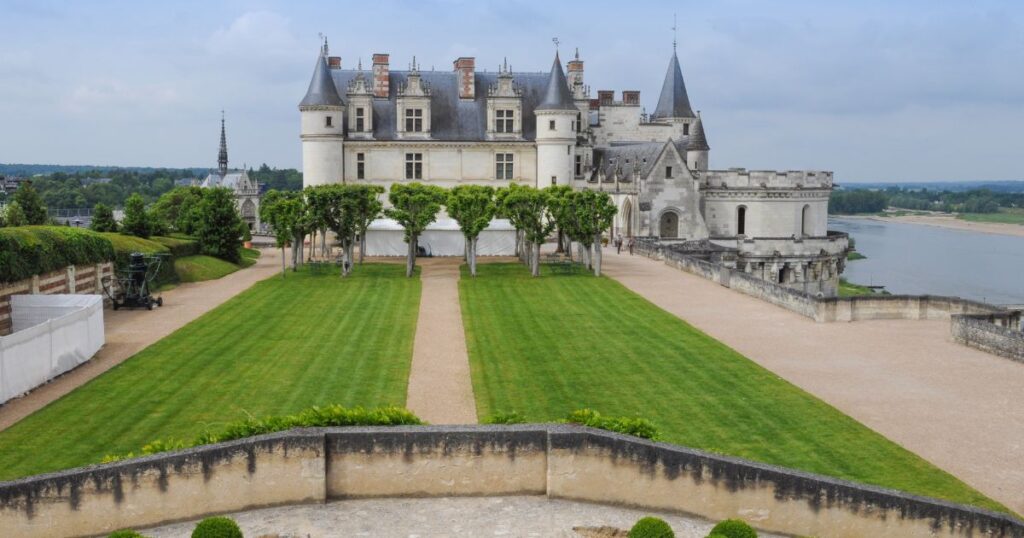
Château de Pierrefonds
A neo-medieval marvel restored by Viollet-le-Duc, Pierrefonds mixes authentic fortifications with 19th-century romantic imagination, making it a frequent film and TV location.

Château de Chinon
A hilltop fortress tied to Joan of Arc and Plantagenet rule, Chinon offers an authentic medieval setting where French and English royal histories intersect.
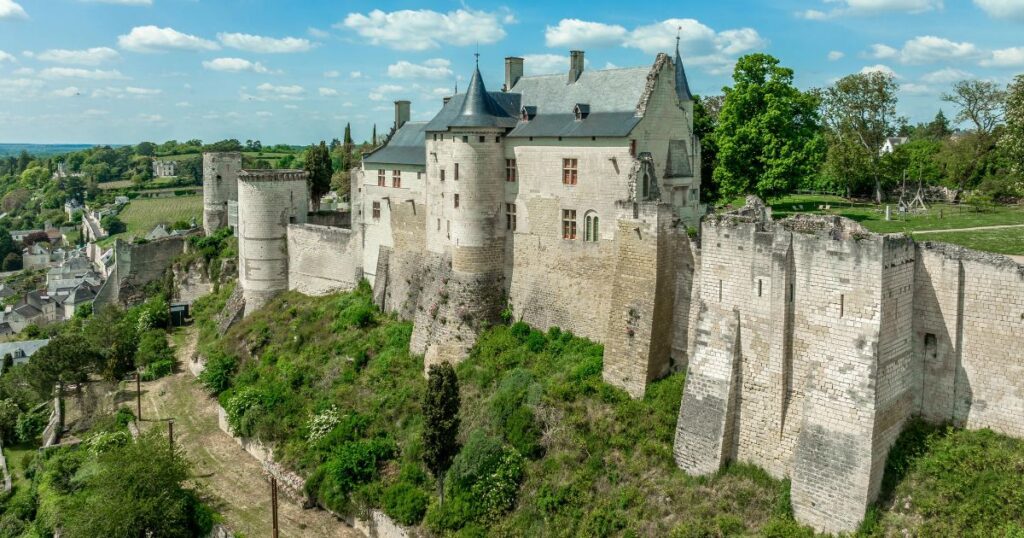
Château de Villandry
A graceful Renaissance estate best known for its elaborate, geometric gardens, Villandry delights travelers with its terraced parterres and beautifully maintained grounds.
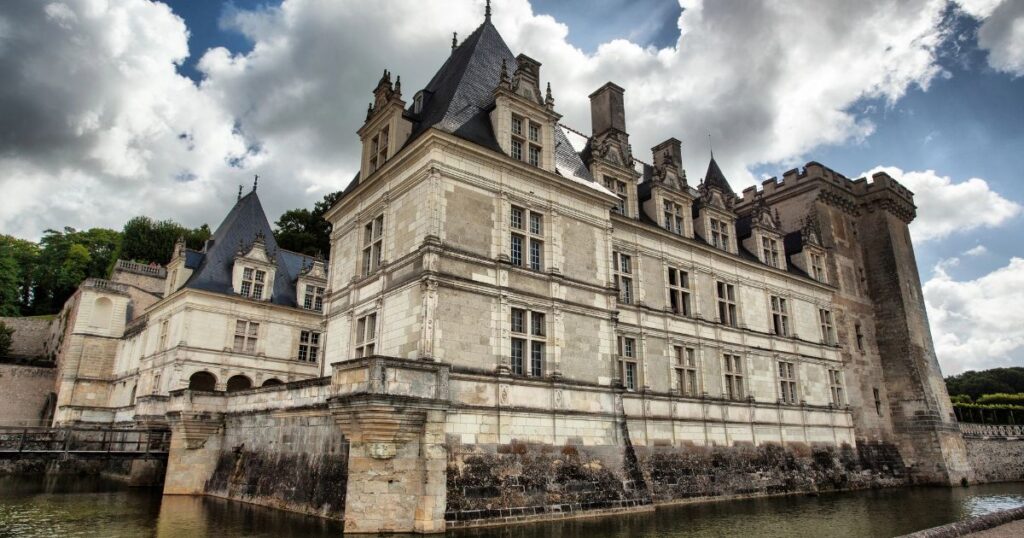
Château de Cheverny
A classical château renowned for its pristine interiors and long familial ownership, Cheverny inspired Captain Haddock’s Marlinspike Hall in Tintin and remains one of the most elegant châteaux in France.
Castle Gardens & Landscapes in France
Castle gardens in France are not merely decorative; they are cultural achievements in their own right — outdoor masterpieces shaped by centuries of artistic vision, royal ambition, and shifting tastes. From the perfectly clipped symmetry of Renaissance parterres to Baroque gardens engineered on monumental scales, these landscapes are among the most recognizable expressions of French identity. Many visitors discover that the gardens surrounding a château are just as compelling as the architecture itself.
Renaissance Innovation: Gardens as Living Art
During the French Renaissance, garden design underwent a radical transformation. Influenced by Italian humanism, châteaux adopted gardens that emphasized order, proportion, and visual harmony. These outdoor spaces were carefully crafted to reflect the beauty of nature through geometry and symmetry — a philosophy that shaped some of France’s most beloved gardens. Common garden features include:
- Embroidered parterres filled with boxwood, flowers, and gravel in intricate patterns
- Reflecting pools that extended the architecture visually into the landscape
- Ornamental groves arranged with precise mathematical balance
- Water staircases and terraces that linked the upper gardens with riverbanks below
Villandry, perhaps the finest example, remains a living testament to Renaissance artistry.
Baroque Grandeur: Gardens of Power
The 17th century elevated gardens from elegant designs to monumental statements of political and cultural dominance. Under Louis XIV and his brilliant landscape architect André Le Nôtre, French gardens became an emblem of the monarchy’s power. These were grand, theatrical spaces meant to impress ambassadors, foreign dignitaries, and courtiers. Signature Baroque elements include:
- Long axial avenues guiding the eye toward distant horizons
- Broad reflecting canals creating dramatic sightlines
- Sculpted fountains animated by mythological figures
- Large-scale parterres visible from palace balconies
- Manicured woodland paths offering contrasting shade and intimacy
Versailles set the standard for this era, influencing garden design across Europe.
Naturalistic Landscapes: A Softer Vision
By the 18th and 19th centuries, tastes shifted toward more natural, picturesque landscapes. Many French castles introduced:
- Sweeping lawns
- Romantic water features
- Meandering paths through groves and forests
- Scenic viewpoints designed to frame countryside vistas
These enhancements softened the formality of earlier designs while maintaining an air of refinement. Fontainebleau and Chantilly are excellent examples of this blend of natural beauty and cultivated elegance.
Garden Architecture & Decorative Features
French castle gardens often incorporate architectural elements that extend the château’s presence into the landscape:
- Orangeries filled with citrus trees during the warmer months
- Garden pavilions and belvederes used for leisure and contemplation
- Sculpture galleries and open-air theaters
- Grand staircases connecting multiple terraces
- Mazes and topiary art providing playful, interactive experiences
These structures reflect the sophistication and creativity of French garden design, turning outdoor areas into extensions of the château’s artistic identity.
Seasonal Beauty: Gardens That Change With the Year
One of the delights of visiting castle gardens in France is experiencing how dramatically they shift with the seasons:
- Spring brings fresh blossoms, tulips, and newly clipped hedges
- Summer showcases vibrant flowerbeds and full fountains
- Autumn deepens colors across the forests and vineyards
- Winter reveals the skeletal geometry of parterres and avenues
Many gardens, especially in the Loire Valley, offer special seasonal events like light shows, art installations, and holiday illuminations.
Castle Restoration & Preservation in France
France’s castles have survived wars, revolutions, abandonment, fires, and the natural decay of time – yet many stand today in remarkable condition thanks to centuries of dedicated restoration work. Preserving these architectural treasures is a national priority in France, involving government agencies, private foundations, skilled artisans, and international heritage organizations. The result is a country where thousands of châteaux, fortresses, and palaces continue to thrive as living landmarks.
National Protection: Government Leadership in Preservation
France established some of Europe’s earliest national heritage laws, recognizing castles as vital cultural assets. Today, the Centre des monuments nationaux (CMN) oversees nearly 100 major monuments, including several castles and fortified sites. Through this organization, the government manages:
- Structural repairs
- Archaeological research
- Visitor programs and exhibitions
- Long-term restoration projects
Many castles also receive classification as Monuments Historiques, granting them legal protection and access to preservation funding.
UNESCO Support & Global Recognition
Several of France’s most famous castle regions hold UNESCO World Heritage status, including the Loire Valley, Carcassonne, and Versailles. UNESCO designations bring:
- Increased funding and global visibility
- Rigorous preservation standards
- International oversight and collaboration
- Enhanced tourism support
These recognitions help ensure that restoration projects maintain historical authenticity.
Private Foundations & Family Stewardship
Not all castles in France are government-operated. Many remain in the hands of families who have owned them for centuries. Their commitment has preserved rare interiors and collections that might otherwise have vanished. Private ownership often supports:
- Authentic room reconstructions
- Conservation of archives, manuscripts, and artwork
- Garden maintenance and restoration
- Creative public programming such as concerts, festivals, and exhibitions
Château de Cheverny and Château de Vaux-le-Vicomte are excellent examples of long-term private stewardship done exceptionally well.
19th-Century Revival & the Legacy of Viollet-le-Duc
The 19th century ushered in a wave of castle restoration inspired by Romanticism and a renewed interest in medieval heritage. The most influential figure of this era was Eugène Viollet-le-Duc, whose work dramatically reshaped castles like Pierrefonds, Carcassonne, and Notre-Dame de Paris.
While some of his reconstructions reflect an idealized medieval vision rather than strict historical accuracy, his impact on French heritage preservation is undeniable. His projects saved numerous castles from collapse and reignited public interest in architectural conservation.
Modern Restoration Techniques & Skilled Craftspeople
Contemporary preservation efforts rely on advanced research and centuries-old craftsmanship working side by side. Restoration teams today may use:
- Laser scanning and 3D modeling
- Traditional stone masonry and lime plaster work
- Archaeological excavation
- Structural reinforcement and seismic stabilization
- Roof restoration using historically accurate slate or tile
These projects often involve master artisans – stonemasons, carpenters, sculptors, and metalworkers – who keep medieval and Renaissance techniques alive.
Sustainable Preservation & Tourism Funding
Tourism plays an essential role in funding castle maintenance. Entrance fees, special exhibitions, night tours, festivals, and garden events all support ongoing restoration work. Many châteaux now implement:
- Green energy upgrades
- Eco-friendly visitor facilities
- Sustainable landscape management
- Reduced-impact lighting for nighttime displays
This balance ensures that castles remain both historically authentic and viable for future generations of visitors.
Notable Figures & Events
These are some historically notable figures and events tied to castles in France — moments and personalities that shaped the architectural landscape, shifted political power, and left lasting marks on the nation’s heritage. Their stories unfold across the halls, ramparts, and gardens of France’s most iconic châteaux.
Joan of Arc at Château de Chinon
In 1429, Joan of Arc traveled to Château de Chinon to persuade Charles VII to grant her an army to lift the siege of Orléans. Her arrival and private audience with the dauphin inside Chinon’s great hall became one of the turning points of the Hundred Years’ War and cemented the castle’s place in French national identity.
Leonardo da Vinci at Amboise
Invited by King Francis I, Leonardo da Vinci spent the final years of his life in France, residing at Clos Lucé, directly linked to Château d’Amboise. Leonardo’s presence contributed to the spread of Renaissance ideas, engineering, and artistic innovation throughout the Loire Valley. He is buried in Amboise’s Saint-Hubert Chapel.
Catherine de’ Medici at Chenonceau and Beyond
A powerful queen and regent, Catherine de’ Medici shaped the political and cultural landscape of Renaissance France. Her contributions to Château de Chenonceau — including extensive expansions, gardens, and grand celebrations — helped define it as one of the Loire’s most elegant châteaux. Her courtly influence extended to numerous castles across France.
Louis XIV and the Creation of Versailles
The “Sun King,” Louis XIV, transformed Versailles from a modest hunting lodge into one of the most influential palaces in European history. Under his rule, it became the dazzling stage of royal power, hosting elaborate ceremonies, diplomatic events, and artistic patronage that shaped the Baroque era.
Napoleon I at Fontainebleau
Napoleon’s relationship with Château de Fontainebleau was complex and deeply symbolic. He used the palace as an imperial residence, signed a series of key decrees there, and famously bid farewell to the Old Guard on its grand staircase in 1814. Fontainebleau remains one of the most complete testimonies to the Napoleonic era.
The Albigensian Crusade and Cathar Castles of the South
During the 13th century, the Albigensian Crusade reshaped the landscape of Occitanie, leaving behind dramatic fortresses such as Montségur, Peyrepertuse, and Quéribus. These strongholds became symbols of resistance, tragedy, and spiritual defiance, and their ruins remain among France’s most haunting sites.
The Restoration Era and Viollet-le-Duc’s Influence
In the 19th century, architect Eugène Viollet-le-Duc revived numerous medieval castles – Carcassonne and Pierrefonds among them. His imaginative reconstructions sparked renewed public interest in medieval heritage and helped rescue dozens of fortresses from ruin.
Castles in Modern French Culture
Castles in France are not relics frozen in time – they continue to play an active role in modern culture. From blockbuster film locations and beloved television settings to sources of artistic inspiration and fashion editorials, French châteaux remain vibrant touchpoints in contemporary storytelling. Their dramatic silhouettes, lush gardens, and richly layered histories make them irresistible backdrops for creative industries around the world.
Film & Television: Iconic Backdrops for Global Audiences
Many French castles appear in films, TV series, and documentaries, introducing their beauty to international audiences and inspiring new generations of travelers. Some notable examples include:
- Château de Pierrefonds – Featured prominently in the BBC series Merlin, this neo-medieval reconstruction provides a dreamlike vision of Camelot.
- Château de Chambord – Appears in multiple historical and fantasy productions, often representing Renaissance splendor.
- Château de Fontainebleau – Used in period dramas and documentaries for its remarkably preserved interiors and imperial apartments.
- Carcassonne – With its double walls and medieval skyline, the citadel serves as a frequent stand-in for fortified medieval cities.
These appearances reinforce France’s reputation as a cinematic treasure trove.
Fashion, Art, and Photography
French castles often serve as dramatic stages and backdrops for haute couture fashion shoots, luxury brand campaigns, and editorial spreads. Designers and photographers are drawn to elements like this:
- Grand staircases
- Ornamental gardens
- Long perspective lines of Baroque avenues
- Tall windows and richly decorated salons
Versailles and Chenonceau are especially popular locations for fashion houses due to their opulent architecture and sense of timeless elegance.
Museums, Cultural Centers & Modern Exhibitions
Many castles have been transformed into cultural institutions that showcase art, history, and innovation:
- Versailles hosts contemporary art installations by internationally renowned artists.
- Fontainebleau offers exhibitions ranging from Napoleonic artifacts to Renaissance decorative arts.
- Smaller châteaux across the Loire Valley now host rotating art shows, sculpture trails, or immersive historical experiences.
These efforts ensure that castles remain active participants in France’s cultural landscape.
Literature & Popular Imagination
Castles have long inspired writers, poets, and novelists. Their atmospheric corridors, hidden staircases, and dramatic histories appear throughout French and international literature. Classic Gothic tales, modern fantasies, historical romances, and mystery novels all find natural homes within castle walls.
Chenonceau’s feminine legacy and Carcassonne’s medieval ambiance, in particular, have inspired countless works of fiction.
Living Heritage: Festivals, Night Shows & Community Events
Many French castles host annual events that bring modern vibrancy to ancient settings:
- Son et lumière (sound-and-light shows) animate castle façades with projected imagery.
- Medieval fairs and reenactments enliven fortress courtyards.
- Summer concerts echo across Renaissance terraces.
- Christmas markets fill château courtyards with lights, craft stalls, and seasonal decorations.
These events promote cultural engagement while generating sustainable tourism revenue used for restoration and maintenance.
Cultural Traditions Linked To French Castles
Castles in France are deeply woven into the cultural fabric of the regions they anchor. Far from being static monuments, they are vibrant centers of tradition — places where history, community, and celebration come together. Many French cultural customs trace their roots to château life, from courtly etiquette and garden design to seasonal festivals that continue today. Exploring these traditions gives visitors a richer, more meaningful connection to the French heritage that shaped each site.
Courtly Life & Aristocratic Rituals
French castles were once the stage for elaborate courtly customs that influenced European culture for centuries. At royal estates like Versailles, etiquette was codified into art:
- Homecomings, audiences, and formal greetings
- Daily rituals that showcased rank and proximity to the king
- State dinners, music, dance, and theatrical performances
These traditions transformed castles into theaters of ceremony and elevated France’s global cultural influence.
Festivals, Feasts & Seasonal Gatherings
Many castles host annual events that echo historical celebrations:
- Harvest festivals rooted in agrarian traditions
- Summer fêtes with dance, fireworks, and open-air concerts
- Christmas markets that fill courtyards with artisanal crafts and glowing lights
- Medieval fairs, complete with costumed reenactors, blacksmith demonstrations, and falconry displays
These modern celebrations draw on centuries-old customs and give visitors a chance to experience castle life as it might have once felt.
Religious Traditions & Chapel Ceremonies
Most castles featured chapels where baptisms, weddings, and holiday masses took place. Today, these spaces often host:
- Classical concerts
- Sacred music performances
- Candlelit Christmas services
- Historical reenactments tied to saints or regional legends
The continuity of spiritual traditions adds depth to many château visits.
Culinary Traditions & Château Kitchens
France’s culinary heritage is inseparable from its castles. Many estates offer:
- Tastings of wines produced in their historic vineyards
- Demonstrations focused on traditional cooking techniques
- Seasonal menus inspired by historic château kitchens
The Loire Valley and Burgundy regions, in particular, blend castle touring with gourmet experiences.
Garden Traditions & Outdoor Rituals
Gardens surrounding French castles were once used for:
- Royal promenades
- Poetry readings and musical performances
- Outdoor games, tournaments, and equestrian events
Today, these traditions continue through:
- Guided garden walks
- Floral shows and horticultural festivals
- Open-air theater and summer concerts
Visitors often find that castle gardens still serve as living cultural stages.
Craftsmanship & Artisan Heritage
The preservation of castles kept alive many traditional French crafts:
- Stone carving
- Slate roofing
- Ironwork
- Tapestry weaving
- Decorative gilding
Many châteaux now host workshops, exhibitions, and demonstrations that showcase these skills, connecting modern audiences with centuries-old techniques.
Legends, Folklore & Ghost Stories
Castles are fertile ground for regional legends – from tales of hidden treasure and protective spirits to darker stories linked to sieges, loves lost, and political intrigue. Many castles embrace this mystical tradition with:
- Night tours
- Storytelling evenings
- Halloween-themed events
- Candlelit explorations of towers and tunnels
These experiences add a layer of enchantment that appeals to visitors of all ages.
Practical Tips For Visiting Castles In France
French castles offer unforgettable experiences, and with a little planning (and a few insider tricks), your visits will be smoother, richer, and far more enjoyable. Below is a streamlined guide to help you make the most of your château adventures.
Trip Planning Essentials
Choose regions based on your interests:
Loire Valley (Renaissance masterpieces & gardens), Normandy/Occitanie (medieval fortresses), Île-de-France (royal palaces), Alsace/Provence (hilltop castles & scenic landscapes).
Getting around:
A car offers maximum flexibility in the Loire, Alsace, Occitanie, and Provence. Castles near Paris (Versailles, Fontainebleau, Vincennes) are easy by train/RER. Guided day tours are great for history-focused travelers.
When to visit:
Early morning or late afternoon for lighter crowds.
Shoulder seasons (Apr–Jun, Sep–Oct) offer ideal weather.
Winter brings reduced hours, and smaller/private châteaux may close.
Book ahead for popular sites:
Versailles, Chambord, Chenonceau, Amboise, Villandry (gardens), and major night shows sell out in high season.
On-Site Advice & Insider Insights
Wear comfortable shoes:
Expect cobblestones, large courtyards, tower staircases, and extensive gardens.
Weather considerations:
Summers in the Loire can be hot; Normandy is cooler and wetter; Occitanie is sunny with little shade. Bring water and sun protection.
Photography:
Most châteaux allow photos but restrict flash, tripods, and drones. Gardens are typically unrestricted and offer the best angles.
Crowds & timing:
Midday is busiest. Weekdays are quieter.
Opt for lesser-known gems like Sully-sur-Loire, Chaumont, or Fougères for a more relaxed visit.
Food & facilities:
Large châteaux often have cafés; smaller sites may not.
Many estates allow picnics in park areas – one of the most charming ways to enjoy the setting.
Accessibility:
Medieval sites can include steep stairs and uneven terrain. Renaissance palaces tend to be more accessible, but always check ahead.
Frequently Asked Questions About Castles In France
How many castles are there in France?
France has more than 45,000 registered châteaux, ranging from medieval keeps and fortress ruins to Renaissance palaces and aristocratic estates.
What are the most famous castles to visit in France?
Some of the most iconic castles include Château de Chambord, Chenonceau, Versailles, Carcassonne, Amboise, Fontainebleau, Pierrefonds, Chinon, Villandry, and Cheverny.
What is the best region to visit for French castles?
The Loire Valley is the most popular region for château visits, especially for Renaissance architecture. Normandy and Occitanie are ideal for medieval fortresses, while Île-de-France offers major royal palaces near Paris.
Are French castles open year-round?
Many major castles, such as Versailles and Chenonceau, are open year-round with reduced winter hours. Smaller or privately owned châteaux may close during the winter months.
Do I need a car to visit French castles?
Not always. Castles near Paris are accessible by train or RER. However, regions like the Loire Valley, Occitanie, Alsace, and Provence are best explored by car or guided tour.
Which castle in France should I visit first?
If you’re a first-time visitor, begin with Château de Chambord for Renaissance grandeur or Versailles for royal opulence. Both offer exceptional architecture and world-class gardens.
What are the best French castles for kids and families?
Carcassonne, Pierrefonds, and Chambord are excellent for children thanks to large outdoor spaces, interactive exhibits, and engaging medieval or Renaissance themes.
Can you stay overnight in a French château?
Yes. Many castles in France have been converted into boutique hotels or bed-and-breakfasts, offering a luxurious and atmospheric way to experience castle life.
Conclusion
Exploring castles in France is far more than a journey through beautiful architecture – it’s an immersion into the heart of French history, culture, and imagination. From the soaring medieval fortresses of Normandy to the river-spanning Renaissance châteaux of the Loire, each site offers its own story, shaped by kings, queens, visionaries, warriors, and centuries of reinvention. Whether you’re admiring the symmetry of a formal garden, tracing the curve of a Gothic tower, or standing in the very hall where Joan of Arc met Charles VII, every castle reveals a different layer of the country’s past.
These remarkable places are not merely monuments to history. They are living landmarks – hosting festivals, preserving traditions, inspiring films and literature, and welcoming millions of travelers who come seeking romance, grandeur, and connection. No matter where your French castle journey begins, you’ll leave with a deeper appreciation for the artistry, resilience, and cultural richness that define France’s enduring legacy.
